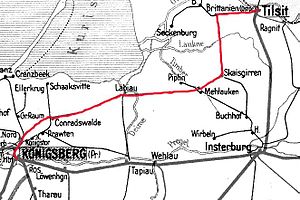Kaliningrad – Sovetsk railway line
| Kaliningrad – Sovetsk | |||||||||||||||||||||||||||||||||||||||||||||||||||||||||||||||||||||||||||||||||||||||||||||||||||||||||||||||||||||||||||||||||||||||||||||||||||||||||||||||||||||||||||||||||||||||||||||||||||||||||||||||||||||||||||||||||||||
|---|---|---|---|---|---|---|---|---|---|---|---|---|---|---|---|---|---|---|---|---|---|---|---|---|---|---|---|---|---|---|---|---|---|---|---|---|---|---|---|---|---|---|---|---|---|---|---|---|---|---|---|---|---|---|---|---|---|---|---|---|---|---|---|---|---|---|---|---|---|---|---|---|---|---|---|---|---|---|---|---|---|---|---|---|---|---|---|---|---|---|---|---|---|---|---|---|---|---|---|---|---|---|---|---|---|---|---|---|---|---|---|---|---|---|---|---|---|---|---|---|---|---|---|---|---|---|---|---|---|---|---|---|---|---|---|---|---|---|---|---|---|---|---|---|---|---|---|---|---|---|---|---|---|---|---|---|---|---|---|---|---|---|---|---|---|---|---|---|---|---|---|---|---|---|---|---|---|---|---|---|---|---|---|---|---|---|---|---|---|---|---|---|---|---|---|---|---|---|---|---|---|---|---|---|---|---|---|---|---|---|---|---|---|---|---|---|---|---|---|---|---|---|---|---|---|---|---|---|---|
|
Route map 1938
| |||||||||||||||||||||||||||||||||||||||||||||||||||||||||||||||||||||||||||||||||||||||||||||||||||||||||||||||||||||||||||||||||||||||||||||||||||||||||||||||||||||||||||||||||||||||||||||||||||||||||||||||||||||||||||||||||||||
| Course book range : | 135q (1944) | ||||||||||||||||||||||||||||||||||||||||||||||||||||||||||||||||||||||||||||||||||||||||||||||||||||||||||||||||||||||||||||||||||||||||||||||||||||||||||||||||||||||||||||||||||||||||||||||||||||||||||||||||||||||||||||||||||||
| Route length: | 123.7 km | ||||||||||||||||||||||||||||||||||||||||||||||||||||||||||||||||||||||||||||||||||||||||||||||||||||||||||||||||||||||||||||||||||||||||||||||||||||||||||||||||||||||||||||||||||||||||||||||||||||||||||||||||||||||||||||||||||||
| Gauge : | until 1947: 1435 mm 1520 mm |
||||||||||||||||||||||||||||||||||||||||||||||||||||||||||||||||||||||||||||||||||||||||||||||||||||||||||||||||||||||||||||||||||||||||||||||||||||||||||||||||||||||||||||||||||||||||||||||||||||||||||||||||||||||||||||||||||||
|
|||||||||||||||||||||||||||||||||||||||||||||||||||||||||||||||||||||||||||||||||||||||||||||||||||||||||||||||||||||||||||||||||||||||||||||||||||||||||||||||||||||||||||||||||||||||||||||||||||||||||||||||||||||||||||||||||||||
The Kaliningrad – Sovetsk (Koenigsberg – Tilsit) railway connects the two largest cities in Russia 's Kaliningrad Oblast .
history
The line was completed in 1889 as the Prussian state railway line from Königsberg to Labiau and in 1891 to Tilsit. It was a branch line to the Prussian Eastern Railway Lines Königsberg – Insterburg and Insterburg – Tilsit. The trains initially ran from the Königsberg Ostbahnhof . Shortly before the First World War, in connection with the expansion of the railway systems in Tilsit, the route in front of the entrance to Tilsit was laid a little further south. With the formation of the Polish Corridor in 1920, the importance of the route increased. In the vernacular, however, the train to Tilsit was called “The raging Lithuanian” because of its leisurely driving style. In 1929 the direct connection between the new Königsberg main train station and Königsberg Nordbahnhof was established and the old section of the route that bypassed Königsberg in the west and north was broken off. In 1943 a junction to Insterburg was added shortly before Tilsit . After the Soviets took over the line , it was given the Russian broad gauge in 1947 .
Possibilities to change to small railways before 1945
- In Konradswalde with the Königsberger Kleinbahn to Schaaksvitte , via Prawten to Königsberg-Königstor or to Tapiau
- In Labiau with the Wehlau – Friedländer Kreisbahn to Tapiau
- In Mehlauken / Liebenfelde with the Insterburger Kleinbahnen to Piplin / Timberhafen and to Insterburg
- In Groß Skaisgirren / Kreuzingen with the Insterburger Kleinbahnen to Insterburg
- In (Great) Brittania with the Elk Lowland Railway to Seckenburg and Karkeln
Web links
Individual evidence
- ↑ German Südbahnhof , not to be confused with the Königsberg Südbahnhof that existed until 1929
- ↑ also Lizentbahnhof called
- ↑ Kilometers from Riga?
- ↑ RJ Müller: Von der Memelniederung und their Elchen in Ostdeutscher Naturwart, 4th year 1931/32, 5th issue, p. 212, online as downloadable from http://www.wmbc.olsztyn.pl/ [PDF file ; 36.65 MB]

